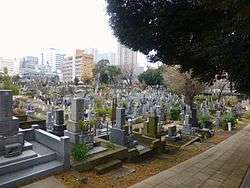Aoyama Cemetery





Aoyama Cemetery (青山霊園 Aoyama reien) is a cemetery in Aoyama, Minato, Tokyo, Japan, managed by the Tokyo Metropolitan Government. The cemetery is also famous for its cherry blossoms, and at the season of hanami, many people visit.
History
The cemetery was originally the land of the Aoyama family of the Gujō clan (now Gujō, Gifu) in the province of Mino (now Gifu). This is Japan's first public cemetery, and in the Meiji era the main locations of Foreigners' graves.[1]
The cemetery has an area of 263,564 m2.
Japanese Section
The Japanese section includes the graves of many notable Japanese, including:
- Amino Kiku
- Gotō Shōjirō
- Ichikawa Danjūrō IX
- Ichikawa Danjūrō XI
- Kitasato Shibasaburō
- Nakae Chōmin
- Nogi Maresuke
- Ōkubo Toshimichi
- Sasaki Takayuki
- Shiga Naoya
- Nishi Takeichi
- Yoshida Shigeru
Foreign Section
The cemetery includes a gaikokujin bochi (foreign cemetery), one of the few such plots in Tokyo. Many of the graves are of foreign experts who came to Japan at the end of the 19th century, as part of the Meiji Government's drive for modernisation. Although some of the graves were threatened with removal in 2005 due to unpaid annual fees, the Foreign Section was awarded special protection in 2007. A plaque on the site recognises the men and women who contributed to Japan's modernization. [2]
Some of the noted foreigners buried within the cemetery:
- Francis Brinkley (1841–1912) Journalist and scholar.
- Edoardo Chiossone (1833–1898), engraver.
- Edwin Dun (1848–1931), American agricultural advisor.
- William Clark Eastlake (1834–87) "Dental Pioneer of the Orient"
- Hugh Fraser (1837–1894), British Envoy Extraordinary and Minister Plenipotentiary to Japan.
- Flora B. Harris, missionary and translator, wife of Merriman Colbert Harris.
- Merriman Colbert Harris (1846–1921) American Methodist missionary.
- Henry Hartshorne (1823–97), Quaker missionary and doctor, father of Anna Hartshorne.
- Joseph Heco (1837–1897), the first naturalized Japanese-American.
- Paul Jacoulet (1902–1960), French-born woodblock print artist in the Japanese style.
- Arthur Lloyd (1852-1911) Anglican Church in Japan minister, Keio University professor and translator.
- Henry Spencer Palmer (1838–1893) British engineer and journalist.
- Julius Scriba (1848–1905), German surgeon.
- Alexander Croft Shaw (1846-1902), Anglican Church in Japan minister, Keio University professor.
- Guido Verbeck (1830–98), Dutch political advisor, educator, and missionary.
- Gottfried Wagener (1831-1892), German chemist, educator and ceramics specialist
- Charles Dickinson West (1847–1908), Irish engineer.
Hachiko's Grave
One of the cemetery's most famous graves is that of Hachikō, the faithful and dutiful dog whose statue adorns Shibuya Station.
Tateyama Branch
The cemetery also has a Tateyama branch, where Nagata Tetsuzan, Kimura Heitarō, and Sagara Sōzō are buried.
See also
References
- This article was originally translated from the Japanese Wikipedia article ja:青山霊園, accessed December 16, 2007
- Who is Buried in the Foreign Section?, The Foreign Section Trust.
- "Resting in Pieces", Metropolis
Coordinates: 35°39′58″N 139°43′20″E / 35.66605°N 139.72229°E